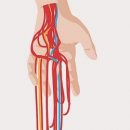Nanotech Engineers Developing Condoms As ‘Thin As a Human Hair’
Plant nano-additives could improve latex while maintaining durability.
The Australian Institute for Bioengineering and Nanotechnology (AIBN) at the University of Queensland has announced the development of an ultra-thin latex made from a native grass called spinifex.
Professor Darren Martin of AIBN said this new material shows great promise in creating condoms with the same strength as existing latex brands but that are considerably thinner—and thus much more comfortable to wear.
 |
“We think we can engineer a latex condom that’s about 30% thinner, and will still pass all standards, and with more process optimisation work we will be able to make devices even thinner than this,” he said in a press release.
The release also states the improved latex could “make condoms as thin as a human hair without any loss in strength.”
While an effective means of birth control and in preventing Sexually Transmitted Diseases (STDs), condoms, unfortunately, are still unpopular with many men. This is mostly due to a perceived lack of sensation caused by the necessary thickness to stop tearing.
Because of this, there’s a kind of technology arms race to see who can develop the most effective, yet pleasurable condom. One leader of this condom-perfection pursuit is The Bill & Melinda Gates Foundation, which in both 2014 and 2013 spent $1.1 million on several next-generation condom projects.
Other approaches under development include a spray-on form of barrier protection. Michele Chu, for example, is working to develop Girlplay, that could be used by both women and men.
Alas, Girlplay is not yet ready for commercial release, which is another reason why AIBN’s progress is such an exciting development. Since the breakthrough is in latex itself, existing manufacturing and packaging models would not have to be radically altered.
 Spinifex grass is seen in Uluru-KataTjuta National Park in Australia. |
Not only that, but Martin points out that a strong yet ultra-thin condom could be more than a literal savior to millions in regards to STDs and unintended pregnancies. It also holds the possibility of being cost effective for the manufacturer— and so much more affordable for the purchaser:
“Because you would also use less latex, your material cost in production would potentially drop as well,” said Martin.
The grass, spinifex, has been used by indigenous Australians for generations. Because of this, the University of Queensland and the Dugalunji Aboriginal Corporation have entered into an agreement acknowledging the long knowledge of the material by indigenous Australians and guaranteeing that they will be involved in the commercial development of the latex.
The impact of the new latex material was emphasized by University of Queensland Vice-Chancellor and President Professor Peter Høj.
“Research like this has great potential to make a difference in the fight against HIV and AIDS and other global issues in healthcare,” he said.
Image sources: University Of Queensland, Nathan Siemers
Leave a reply
You must be logged in to post a comment.

















